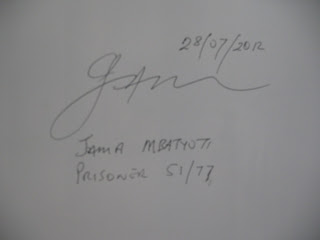After our intense morning at Shikaya, we had no time to sit back and reflect on all that we had learned.
We had already packed our bags and brought them with us in the van to Shikaya. Now, almost noon, it was time to head to theCape Town airport to begin the long, almost 9000-mile trip back to the United States
Our route had three legs:
When you see it on a map, it looks about as long as it felt:
As we took off fromCape Town
We had already packed our bags and brought them with us in the van to Shikaya. Now, almost noon, it was time to head to the
Our route had three legs:
- Cape Town to Johannesburg
- Johannesburg to JFK Airport in New York
- New York to Boston, Massachusetts
When you see it on a map, it looks about as long as it felt:
(Map created using Google Maps!)
As we took off from
 |
| (Cape Town harbor with Table Mountain in the background) |
 |
| (Robben Island) |
Oddly enough, the return trip did not seem as long as the flight down. It wasn’t that I was used to sitting on a plane for 15 hours – who could be? I think it might have had something to do with all the experiences swimming around my head. I still had many blog entries to write up, so I managed to write down about 10 notebook pages of rough drafts before I finally gave up. That took up about four hours. This time I watched four movies: The Avengers, The Truman Show, Men in Black, and a documentary on Nelson Mandela). There went another five hours. Let’s not forget five more chess games against the computer (final score: 2 wins, 1 loss and 2 draws)!... That got me through three hours. Factor in a few long naps, about ten jogs around the aisles of the plane and, of course, two meals, and you’ve just about totaled 15 hours.
If I could pass along one bit of travel advice, it would be: take note of flights fromJohannesburg to the USA
By the time we touched down atLogan Airport in Boston Cape Town , South Africa
If I could pass along one bit of travel advice, it would be: take note of flights from
By the time we touched down at
Whoa.
















































